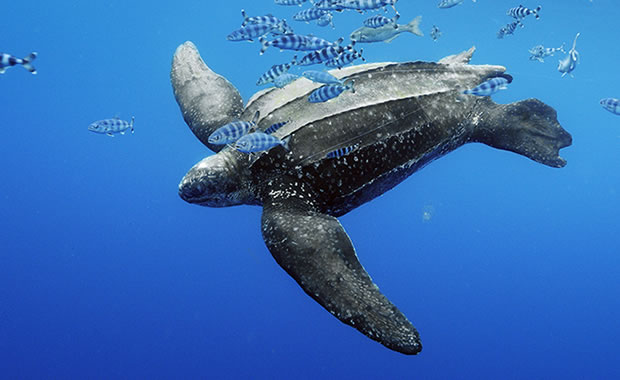
Creature Profile
The Basking Shark is an extra large water species from the class of animals called Chondrichthyes and family Cetorhinidae. It is one of the largest sharks only second to the whale shark. It is easily identified by its enormous mouth which it often leaves open in order to filter food materials. This mouth has sub-terminal mouth that is huge and has tiny teeth that are hooked. Its huge body is covered with placoid scales and is colored blackish to gray with a brownish tinge or blue-grey. The head of this species is encircled by large gill slits and its gill rakers are denticle. It has a pointed snout. Adults can weigh up to 8818.5 pounds and can measure up to 598.4 inches long.
This species is highly migratory. It occurs in offshore waters just after the surf zone, bays, and on insular or continental shelves. It is found in warm temperate to boreal areas in summer month and in deeper waters during winter. Long transoceanic migration are done in which the Basking Shark crosses from one hemisphere to the other. It feeds on filter feed such as cope-pods, plankton, fish eggs and larvae. Breeding activities begins by pairing of two distinct individuals often in early summer. Mating behaviors in the Basking Shark include parallel swimming, nudging, nose to tail following, pectoral biting, and the male getting on top of the female. This species practices ovoviviparity whereby the embryos develop in eggs with the mothers womb. The embryo feeds on the ova produced by mother when it hatches. Gestation lasts between 12 to 36 months after which up to 6 young are born. Young are usually around 6 feet long at birth.
Basking shark is highly valued in the commercial fishing industries mostly for its liver oil, hind, and carcass for fish-meal. It is often caught as a by catch and is also used for medicinal purposes. This species occurs in several protected waters. It is listed on Appendix I of the Bern Convention, in Appendix III of CITES, and on Annex II of the Barcelona Convention for the Protection of the Mediterranean Sea. Fishing of this creature for commercial purposes is prohibited. However despite these conservation measures this species continues to decline. Its population size is not known.
Wikipedia Article

|
Wikipedia Article Copyright Notice: This article is licensed under the GNU Free Documentation License. It uses material from the Wikipedia article "Basking shark". |
March 19, 2023
Glenn, C. R. 2006. "Earth's Endangered Creatures - Basking Shark Facts" (Online). Accessed 4/18/2024 at http://earthsendangered.com/profile.asp?sp=14028&ID=3.
Need more Basking Shark facts?



